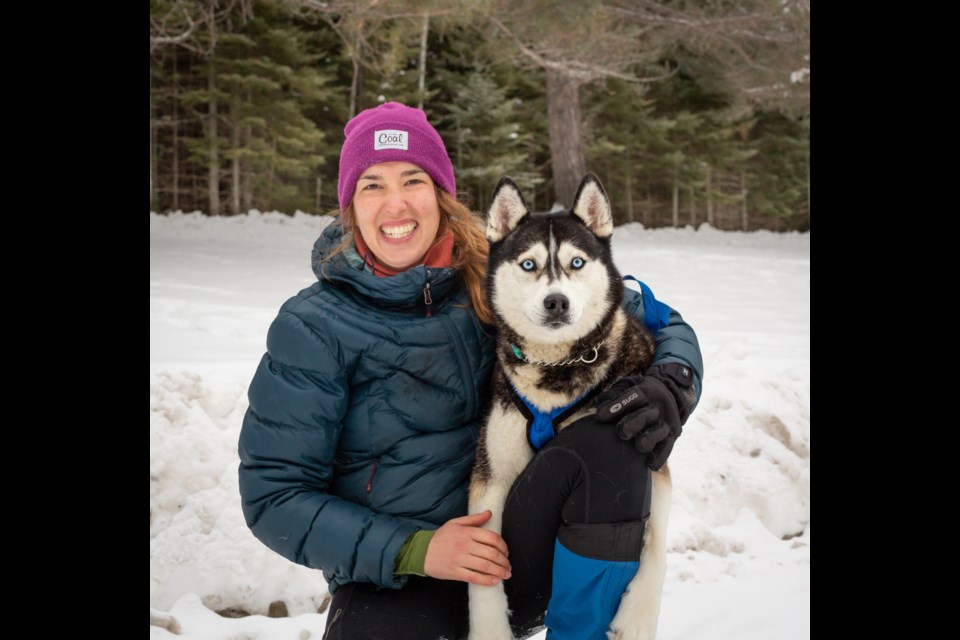THUNDER BAY -- “Right now lots of people are looking for a new sport,” says Sonia Kaminski, who created a Facebook group, Thunder Bay Skijoring, to connect with other skijorers. She hopes more people will try skijoring, since the Thunder Bay Area has many trails and a large number of Husky-type dogs.
Kaminski’s dog Willow was her “intro into the skijoring world.” Several years ago, she spent a winter working with sled dogs near North Bay. One of the dogs, Willow, was ready for early retirement (“she’s more a people dog,”) so Kaminski adopted her and started skijoring with her.
Kaminski moved to Thunder Bay two years ago, and as Willow got older, she started looking for other dogs to skijor with. She met a friend’s dog, Echo, who was newly adopted from the Humane Society. “Willow taught Echo everything she knows,” Kaminski says.
The biggest problems for a dog just starting out are distractions (squirrel! Another dog! Deer!) and hesitancy to pull. Most dogs are taught pulling is bad. “Willow helped her [Echo] get paced, stay on trail and avoid distractions,” recalls Kaminski. “Willow would shoulder bump Echo if she was going after a squirrel and redirect her.”
For those who don’t have a trained skijoring dog to practice with, Kaminski recommends starting out by trail running with your dog in a harness. (Gear can be purchased at Chaltrek in town.) “You can work on voice commands and go on a trail so that you can test out how they react to distractions. The worst is when you’re going 30 kilometres per hour on skis and they see a squirrel.”
Although puppies have lots of energy, a dog should be 18 months old before they start pulling, Kaminski says. “You have to wait for the plates in their spine to be fully fused.”
She spent about three months running with Echo, then tried on skis. “She did great! Learning a new sport takes time for dogs, too.”
This winter, the pair have mostly been bikejoring (on a fat bike,) since the trails haven’t been ideal for skiing. For beginners, Kaminski recommends the tree farm, because it is flat. Dudley’s at KamView is off leash, but is a nice trail. A frozen lake is also a good place to try (if the ice is thick enough) because there are no trees to crash into. Once you and your dog are into the sport, it may be worth a drive out to Sleeping Giant.
Kaminski created the Thunder Bay Skijoring Facebook group to connect with other enthusiasts. There are numerous places to skijor that aren’t official trails, so the group is a great place to find out about good spots and trail conditions.
Even if you are comfortable skiing, it’s important to remember that going downhill, your dog can pull you to speeds almost twice as fast as you’re used to, Kaminski points out. A helmet is a must. “There are going to be some good wipeouts. Things will happen, quicker than you imagine. But it’s a really fun learning process.”
Since starting skijoring, Echo has become calmer around the house, her owner says. Pulling on the leash on regular walks is not a problem. “Dogs learn to tell the difference between a normal walk and a pulling run,” Kaminski says. “I can show Willow two harnesses and she will pick the one she feels like.”
Kaminski reminds people that skijoring is a team sport. “Sometimes I’ve gone out, and Echo’s not feeling it. Maybe she’s not in the mood. Maybe she’s tired.” It’s important to remember that it’s not always going to be the way you want it to be. “You’re working together - it’s supposed to be fun. Enjoy it!”



